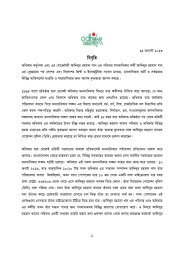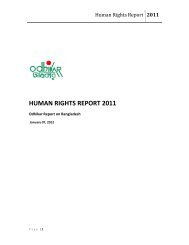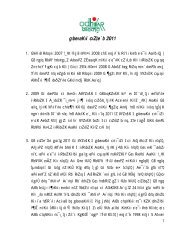Please - Odhikar
Please - Odhikar
Please - Odhikar
Create successful ePaper yourself
Turn your PDF publications into a flip-book with our unique Google optimized e-Paper software.
name of eviction, etc., but also become vulnerable during their adolescence and often become<br />
victims of sexual exploitation by hoodlums and even by the neighbors. Many also turn to cheap<br />
drugs. Ultimately they might be picked up and sold to the brothels and even trafficked to other<br />
cities. There is another category of children known as ‘missing children’. Recently in an article<br />
in a national police journal, one of the IG of Police Mr. Nair, wrote that 15 to 20 thousand<br />
children get 'lost' every year, of which 15 to 20 % are traced and the rest remain untraced.<br />
Where do these children go? It is an easy guess that most of the children are trafficked and sold<br />
to the brothels. Community leaders, religious leaders and even family members have not<br />
accepted these victimized girls and the abusers that are caught get freed due to pressure by<br />
vested interest and powerful groups. There are government and NGOs run homes for such girls,<br />
as is provided in the national plan of action 1988, or under different Acts. India has signed<br />
CEDAW as well as SAARC Convention for Preventing and Combating Trafficking in Children<br />
and Women for Prostitution. The country is bound to follow the norms and sections of these<br />
Conventions and Acts. The Prevention of Social Exploitation Act, 1988 provides shelter for<br />
rescued girls and women, restoration of such to their families in case of cross-border trafficking.<br />
These are also provisions for counseling, vocational and educational training and recreation in<br />
all the homes run by the government and NGOs. In most of the cases the family does not want to<br />
take back the girl child on the pretext that a daughter/other daughters of the family have to be<br />
given into marriage and they cannot take back the trafficked and sexually exploited girl because<br />
they will be socially boycotted. There are some families and parents who, after several family<br />
counseling session, have agreed to take back the girls who have fallen victim to sexual attacks or<br />
trafficking. The fact remains that most of the girls remain unaccepted to the community and<br />
families. Lot of awareness rising at the community level needs to be done in order to bring about<br />
attitudinal changes towards the victims. The existing situation in the lower judiciary and police<br />
stations and their methods of treating such victims must change radically. To change such<br />
situations mass awareness programs should be organized. Sensitisation of police, panchayet, and<br />
judiciary on this issue is vital for restoration and reintegration of victimized girls. For economic<br />
independence, vocational training and financial help must be ensured for such girls for social<br />
reintegration. Poverty alleviation programs need to be taken up in the economically backward<br />
areas. Young adolescents need to be educated on sex and sexuality and how to protect<br />
themselves at times of necessity. There are number of NGOs and other organizations in India<br />
and also the State government that have developed shelter homes keeping in mind the welfare<br />
and rehabilitation of such victimized girls.<br />
Lastly, let me give you an example of another type of victim. It happened a few months back on<br />
a hot day somewhere in south India. A thirsty person came near a well to drink water. For doing<br />
so, the person was not only severely beaten but also sent to police station on different charges.<br />
Unfortunately the reason was that the well was made for the use of people of the 'higher caste'<br />
and the person belonged to a scheduled caste. So he was not allowed to take water from that<br />
well. To my mind this is another case of victimisation. To protect the interest of the victim and<br />
witness, one cannot ignore the socio-economic and political dimensions. The victims are often<br />
the results of the given socio-economic and political process. Since this is an inequality, the<br />
cases may not come up at the appropriate level and be referred for justice.<br />
Farhad Mazhar: These issues need to be considered as well. However, these are not universal<br />
cases, but particular cases. When a particular case is important- Jogitabala for example, and the<br />
Report 2005<br />
69











